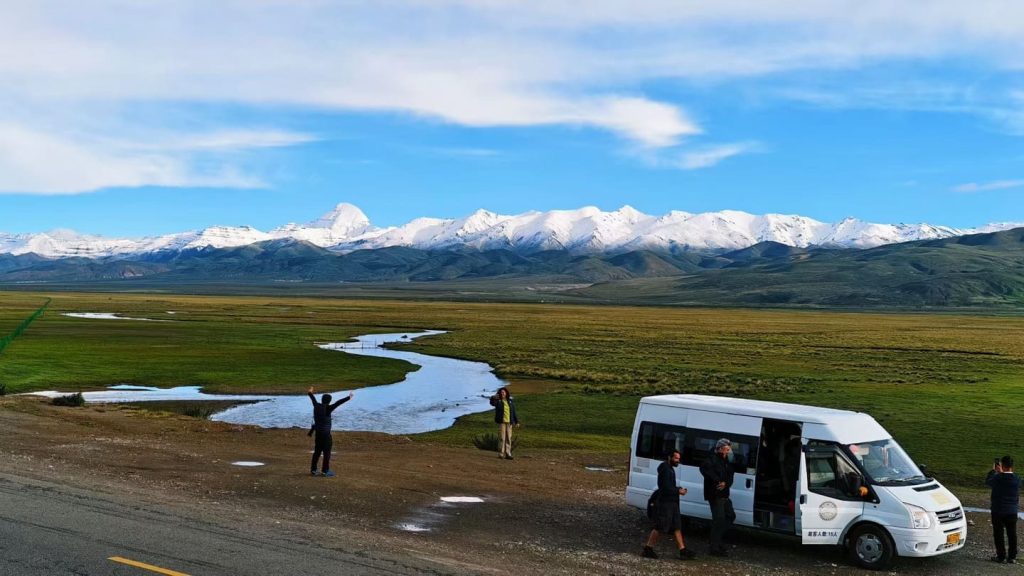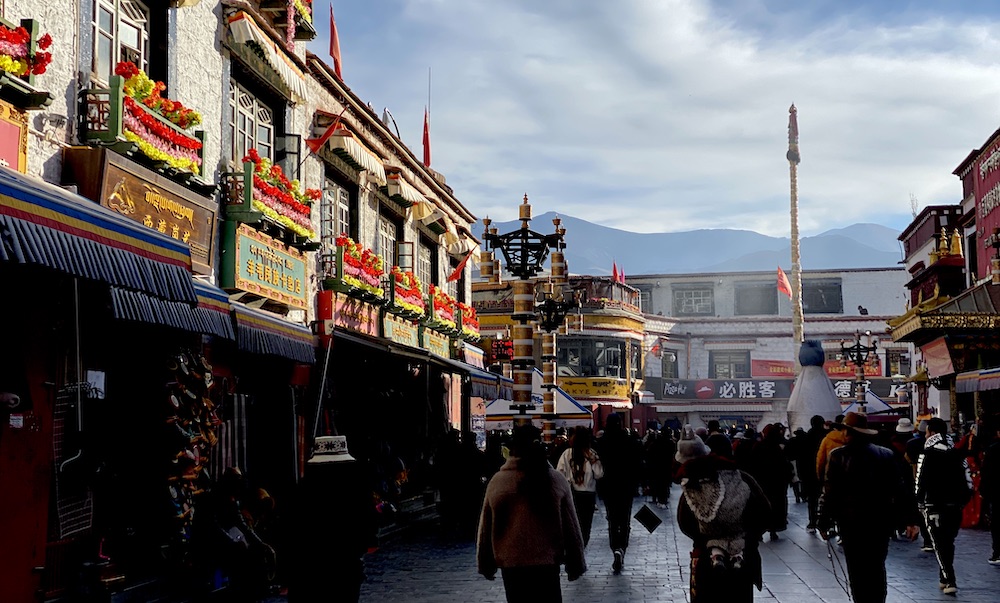Tibet, often called the “Roof of the World,” is a place like no other. Nestled high in the Himalayas, this region offers a unique blend of breathtaking landscapes, rich spiritual traditions, and a sense of profound peace that few places on Earth can rival. While many people flock to Tibet in the warmer months to trek, hike, and experience its spiritual heritage, the winter months present an entirely different, more intimate side of this mystical land.
Tibet in winter is quieter, less crowded, and offers some of the most beautiful landscapes, crystal-clear skies, and unforgettable experiences. The snow-covered mountains, frozen lakes, and sacred monasteries all take on a serene and peaceful quality during the cold season. If you’ve ever wondered what it would be like to explore this high-altitude wonderland when most of the world stays away, winter is the perfect time for a truly magical Tibet adventure.
In this blog post, we will take you on a journey through some of the most incredible places to visit in Tibet in winter. From bustling cities to serene lakes and towering mountain ranges, we’ll explore the destinations that make a winter trip to Tibet an unforgettable experience.

Why Winter is the Best Time to Visit Tibet
Before diving into the specific places, it’s worth mentioning why visiting Tibet in winter is such a unique and rewarding experience:
1. Fewer Tourists: Winter in Tibet sees fewer visitors compared to the busy summer months. This means you’ll have the region’s most famous sites—like the Potala Palace, Jokhang Temple, and Mount Everest Base Camp—almost entirely to yourself. The lack of crowds makes for a peaceful, reflective experience that’s hard to replicate during the high season.
2. Unparalleled Scenic Beauty: The winter landscapes of Tibet are stunning. Snow-covered mountains, frozen lakes, and clear blue skies make this season one of the best times to enjoy the natural beauty of the region. The cold, dry air allows for crystal-clear views of iconic peaks like Mount Everest and the surrounding Tibetan Plateau.
3. Cultural Festivals: Winter is the time of the Tibetan New Year, or Losar, which typically takes place in February or March. Losar is a vibrant celebration with traditional dances, music, and ceremonies, offering a unique cultural experience for visitors.
4. Affordable Travel: Since winter is the off-season for tourism, many hotels and tour companies offer discounted prices during this time. If you’re looking to visit Tibet on a budget, this is the best time to go.

Best Places to Visit in Tibet in Winter
Now that we’ve covered why winter is a great time to visit Tibet, let’s explore the top destinations that you must visit during this season.
1. Lhasa: The Spiritual Heart of Tibet
Lhasa, the capital of Tibet, is often the starting point for most visitors. Known for its rich cultural heritage and spiritual significance, Lhasa is a city steeped in history. While it’s one of the most visited places in Tibet, winter provides a quieter, more reflective experience.
Key Places to Visit in Lhasa:
• Potala Palace: This iconic structure is the most recognizable symbol of Tibet and one of the highest palaces in the world. In winter, the Potala Palace is quieter, allowing you to fully appreciate its awe-inspiring architecture, intricate murals, and stunning views of the city and surrounding mountains. The cold, dry air during winter also offers clearer skies for panoramic shots of the palace.
• Jokhang Temple: As Tibet’s holiest temple, Jokhang is a must-see in Lhasa. Pilgrims from all over Tibet come to worship at this sacred site, and you can often find them circumnavigating the temple, praying, and offering butter lamps. The quiet atmosphere in winter lets you take in the temple’s peaceful aura and observe the local customs and rituals with less disturbance.
• Barkhor Street: Around Jokhang Temple, you’ll find Barkhor Street, a bustling market where pilgrims and locals sell traditional Tibetan goods like prayer wheels, thangkas (Tibetan paintings), and scarves. In winter, the street is less crowded, and you can enjoy shopping for souvenirs or simply watching the daily life of Lhasa unfold.

• Norbulingka Palace: Known as the “Summer Palace of the Dalai Lama,” Norbulingka is a beautiful garden and palace complex. Although most visitors come during the warmer months, Norbulingka retains its charm in winter with fewer crowds. Strolling through the quiet gardens and exploring the various palaces and temples provides a peaceful, almost meditative experience.
2. Mount Everest Base Camp: A Winter Wonderland
For adventure-seekers and those looking to experience the majesty of the Himalayas, Mount Everest Base Camp is one of the most iconic destinations in Tibet. Although the harsh winter conditions make it challenging to trek to base camp, the views of Mount Everest during the winter months are unparalleled.
What to Expect at Everest Base Camp in Winter:
• Snow-Capped Peaks: Mount Everest’s towering presence is awe-inspiring at any time of year, but winter adds an extra layer of beauty. The surrounding peaks are covered in snow, and the clear winter air provides excellent visibility of Everest and other majestic Himalayan peaks.
• Fewer Tourists: Winter is a quiet time at Everest Base Camp, and you may have the area to yourself, which is a rare and special experience. The absence of large crowds allows for a more intimate and spiritual connection to this sacred place.
• Challenging Trekking Conditions: While trekking to Everest Base Camp in winter can be difficult due to cold temperatures and snow, it’s still a viable option for experienced trekkers. Make sure to bring appropriate gear, such as high-quality boots, layered clothing, and a good sleeping bag, as temperatures can drop to well below freezing at night.
3. Namtso Lake: A Frozen Paradise
Namtso Lake is one of the most beautiful and sacred lakes in Tibet. Located about 250 kilometers north of Lhasa, the lake is renowned for its stunning views, crystal-clear waters, and serene atmosphere. In winter, the lake’s surface often freezes, creating a mesmerizing winter wonderland.
Why Namtso Lake in Winter?
• Frozen Lake: During the winter months, Namtso Lake transforms into a massive frozen expanse of ice. The stillness of the lake, coupled with the snow-capped mountains in the background, makes for a truly magical scene.
• Spiritual Significance: Namtso is considered one of Tibet’s holiest lakes, and many pilgrims make the long journey to the lake to perform religious rituals. Winter, with its tranquil atmosphere, is the perfect time to reflect and soak in the spiritual energy of the lake.
• Breathtaking Views: The high-altitude location of Namtso offers stunning panoramic views of the surrounding mountains. The combination of the frozen lake, blue skies, and distant snow peaks creates a picture-perfect landscape.
4. Gyantse: A Hidden Gem in Tibet
Located about 260 kilometers southwest of Lhasa, Gyantse is one of Tibet’s lesser-known but incredibly beautiful towns. Gyantse is known for its ancient monasteries, historical fortresses, and scenic beauty. In winter, it offers a peaceful and uncrowded alternative to the more popular destinations.
Key Attractions in Gyantse:
• Pelkor Chode Monastery: The Pelkor Chode Monastery is home to the famous Kumbum Stupa, a stunning multi-tiered structure filled with intricate murals and religious artwork. The monastery is a significant spiritual center, and visiting in winter provides a more contemplative experience without the usual crowds.
• Gyantse Dzong: This ancient fortress sits atop a hill and offers sweeping views of the town and the surrounding landscape. The fortress is a historical symbol of Tibetan resilience and has stood for centuries. Winter is a great time to explore Gyantse Dzong, as you can hike to the top without the heat of summer.
5. Shigatse: Gateway to Tibetan Culture
Shigatse, Tibet’s second-largest city, is an excellent base for exploring the cultural heart of the region. It’s an ideal place to learn about Tibet’s history, traditions, and Buddhist culture.
Top Sites in Shigatse:
• Tashilhunpo Monastery: Founded in 1447, Tashilhunpo is one of Tibet’s most important monasteries. It is the seat of the Panchen Lama, one of the highest-ranking spiritual leaders in Tibet. Visiting this monastery in winter allows you to observe daily rituals and practices without the large crowds that gather during the peak tourist season.
• Mount Everest Region: From Shigatse, you can take a scenic drive to Mount Everest Base Camp, passing through the Tibetan Plateau and picturesque villages. The route offers spectacular views of the surrounding mountains, and the clear winter air makes the journey even more breathtaking.
6. Lake Yamdrok: A Sacred Gem
Yamdrok Lake is one of the most sacred lakes in Tibet and offers one of the most beautiful views in the region. Located about 100 kilometers southwest of Lhasa, the lake is surrounded by snow-capped peaks and lush meadows. In winter, the snow-covered landscape and the stillness of the lake create a truly ethereal atmosphere.
Why Visit Yamdrok Lake in Winter?
• Majestic Views: The frozen surface of the lake contrasts beautifully with the snow-capped mountains in the background. The scene is magical, and the winter light makes for great photography.
• Serenity and Peace: Winter brings a sense of calm to Yamdrok Lake. Without the usual crowds, the area becomes a peaceful retreat, allowing for quiet reflection and spiritual connection with the landscape.

Conclusion: The Magic of Tibet in Winter
Visiting Tibet in winter is an experience like no other. From the awe-inspiring Potala Palace in Lhasa to the frozen beauty of Namtso Lake and the spiritual significance of Everest Base Camp, the places to visit in Tibet during this season offer something for every traveler—whether you’re seeking adventure, solitude, or spiritual enlightenment.
The winter months provide a rare opportunity to experience Tibet’s true essence, undisturbed by the usual tourist crowds. With fewer people around, you can immerse yourself in the region’s serene landscapes, sacred traditions, and the timeless beauty of the Himalayas.
So, if you’re looking for a travel experience that combines peace, adventure, culture, and stunning natural beauty, consider visiting Tibet in winter. The Roof of the World is waiting to welcome you with open arms.

[…] the main attraction of the Tibet train journey is the stunning scenery, there are plenty of other ways to make the most of your time on […]